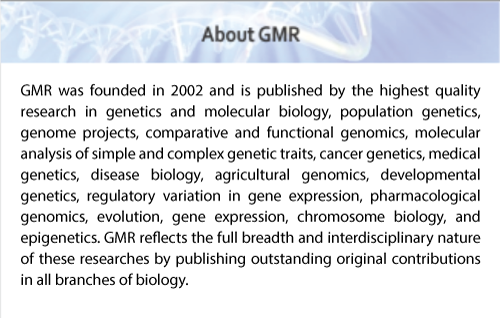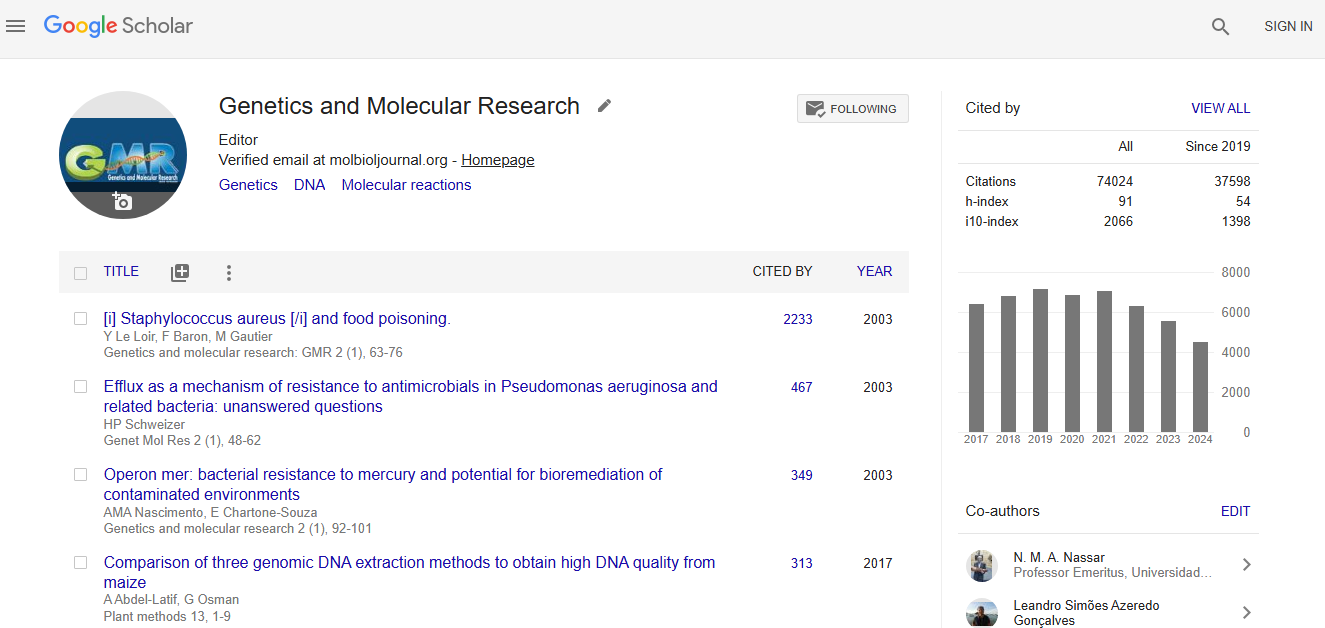
H.D. Vieira
Genetic diversity among 16 genotypes of Coffea arabica in the Brazilian cerrado
For the selection of coffee plants that have favorable characteristics, it is necessary to evaluate variables related to production. Knowledge of the genetic divergence of arabica coffee is of extreme importance, as this knowledge can be associated with plant breeding programs in order to combine genetic divergence with good productive performance. The objective of .. Read More»
Genet. Mol. Res. 16(3): gmr16039794
DOI: 10.4238/gmr16039794
Adaptability and stability of conilon coffee in areas of high altitude
In view of the predicted models of global climate change and differences in prices and production costs, there is increased interest in Coffea canephora cultivation in areas of high altitude. However, this species is sensitive to low temperatures, where genotypes vary regarding adaptation/tolerance mechanisms, demonstrating genotype x environment interaction. The ai.. Read More»
Genet. Mol. Res. 13(3): 2014.September.26.26
DOI: 10.4238/2014.September.26.26
Assessment of genetic divergence among coffee genotypes by Ward-MLM procedure in association with mixed models
Mixed linear models have been used for the analysis of the genetic diversity and provided further accurate results in crops such as eucalyptus, castor, and sugarcane. However, to date, research that combined this analysis with Ward-MLM procedure has not been reported. Therefore, the aim of the present study was to identify divergent coffee genotypes by Ward-MLM proc.. Read More»
Genet. Mol. Res. 15(2): gmr.15027889
DOI: 10.4238/gmr.15027889
Adaptability and genotypic stability of Coffea arabica genotypes based on REML/BLUP analysis in Rio de Janeiro State, Brazil
Biannuality in coffee culture causes temporal variability in plant productivity. Consequently, it is essential to evaluate genotypes during various crop years to ensure selection of productive and stable genotypes. We evaluated the effectiveness of simultaneous selection of coffee genotypes along harvests, based on productivity, stability, and adaptability, via mixed models, for indication of v.. Read More»
Genet. Mol. Res. 12(3): 2013.July.15.2
DOI: 10.4238/2013.July.15.2
Genetic diversity of standard leaf nutrients in Coffea canephora genotypes during phenological phases
Diagnosing foliar nutritional status is essential for fertilizer recommendations and for the identification of nutrient imbalances. This study aimed to verify genetic diversity and establish mean standards (leaf nutrient contents; LNCs) and relationships among leaf nutrients (LNC relationships; LNCRs) in seven conilon coffee genotypes during both pre-flowering and b.. Read More»
Genet. Mol. Res. 15(4): gmr.15048839
DOI: 10.4238/gmr.15048839
Agronomic performance of arabica coffee genotypes in northwest Rio de Janeiro State
Considering the productive potential of arabica coffee in the Rio de Janeiro State and the shortage of breeding programs for this species in the state, this study aimed to evaluate the vegetative and productive characteristics of 25 arabica coffee genotypes to indicate 1 or more varieties for the northwest Rio de Janeiro region. The experiment was in Varre e Sai, RJ.. Read More»
Genet. Mol. Res. 13(3): 2014.July.25.22
DOI: 10.4238/2014.July.25.22
Digital phenotyping for quantification of genetic diversity in inbred guava (Psidium guajava) families
Digital image analysis of seeds has been used for the identification of cultivars, determination of seed color and mechanical damage, and classification of different seed sizes. The aim of the present study was to evaluate the efficiency of digital image analysis of seeds for the quantification of genetic diversity among genotypes of inbred guava (Psidium guajava L... Read More»
Genet. Mol. Res. 16(1): gmr16019474
DOI: 10.4238/gmr16019474
Biometric analysis of arabica coffee grown in low potassium nutrient solution under greenhouse conditions
Genetic parameters and associations between morpho-agronomic traits and nutritional efficiencies of arabica coffee cultivars were estimated to identify promising traits to assist in the selection of coffee genotypes efficient in potassium use, under limiting conditions of this nutrient. The experiment was conducted in a greenhouse with 20 arabica coffee cultivars grown in nutrient solution with.. Read More»
Genet. Mol. Res. 15(3): gmr.15038753
DOI: 10.4238/gmr.15038753
Evaluation of genetic divergence among clones of conilon coffee after scheduled cycle pruning
Coffea canephora genotypes from the breeding program of Instituto Capixaba de Pesquisa e Extensão Rural were evaluated, and genetic diversity was estimated with the aim of future improvement strategies. From an initial group of 55 genotypes, 18 from the region of Castelo, ES, were selected, and three clones of the cultivars “Vitória&rdqu.. Read More»
Genet. Mol. Res. 14(4): 2015.November.30.19
DOI: 10.4238/2015.November.30.19
Evaluation of castor bean genotypes sown in winter and summer at a low altitude
Current demands for the genetic breeding of castor bean include the adaptation of genotypes to low altitudes to expand the potential areas of cultivation. This study was conducted to evaluate the response of different genotypes of castor bean that were sown in winter and summer at a low altitude. The study was conducted in northwestern Rio de Janeiro State at an altitude of 60 m. The treatments.. Read More»
Genet. Mol. Res. 13(4):
Impact Factor an Index

Google scholar citation report
Citations : 74024
Genetics and Molecular Research received 74024 citations as per google scholar report
